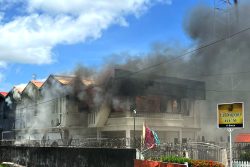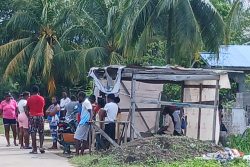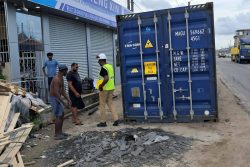 The discussion on the Ogle Housing Project (Prado 1) last week was intended to aid us in understanding the controversy over the Sparendaam Housing Project (Prado 2). It will have been deduced that much of what has taken and is still taking place in the housing sector was/is not based on written law. However, there were and still are some general principles: allottees must be property-less and have the capacity to build; government lots are subsidized; allottees must sign an agreement not to sell the property for 10 years without the permission of Central Housing and Planning Authority (CHPA), can be penalized if they do and are not to be given another government lot. Allocations are generally done on a first-come first-served principle and middle income allottees are usually expected to pay for their infrastructure.
The discussion on the Ogle Housing Project (Prado 1) last week was intended to aid us in understanding the controversy over the Sparendaam Housing Project (Prado 2). It will have been deduced that much of what has taken and is still taking place in the housing sector was/is not based on written law. However, there were and still are some general principles: allottees must be property-less and have the capacity to build; government lots are subsidized; allottees must sign an agreement not to sell the property for 10 years without the permission of Central Housing and Planning Authority (CHPA), can be penalized if they do and are not to be given another government lot. Allocations are generally done on a first-come first-served principle and middle income allottees are usually expected to pay for their infrastructure.
That said, I stated last week that in the late 1990s the ministry did conceive of establishing a higher income housing section as part of the Diamond Housing Scheme project on the East Bank of Demerara. At a time of severe resources shortage, while one of the objectives was to construct a most aesthetically pleasing upper market scheme, foremost in mind was to raise funds to subsidise the other sections of the Diamond housing project. The lots were to be much larger and cost far more than the normal middle income scheme.
However, it had to be recognised that the matter of people not being able to purchase a government lot if they already owned land could be relaxed since the price would be close to actual housing market price and those who were able to afford such lots would most likely already own property. Furthermore, as there were a limited number of lots and the idea was to populate the scheme with persons willing and able to properly maintain it, the allocation process would have been quite subjective.
Utilising some rounded numbers let us now attempt to be as reasonable as possible about what took place at Prado 2. In a nutshell, according to the October 2015 forensic audit of National Industrial and Commercial Investments Ltd. (NICIL), in August 2007, the executive of NICIL informed the board that there were 15 acres of land at Sparendaam that were good for sale. The board decided that it would develop the area into a high income project with lots, town houses and/or condominiums and eventually ‘State funds amounting to $257.049 million were expended on the development of infrastructure, etc.’ at what became known as Prado 2. Included in this amount is $166 million for the removal and relocation of the NCN transmission tower from Sparendaam to Parfait Harmonie, West Bank Demerara.
In about 2010, cabinet decided that while NICIL was to complete the infrastructure works it was to have nothing to do with the actual distribution of lots and the scheme was to now be vested in the CHPA. Using a market value, the audit valued the 15 acres at Prado 2 at $1.242 billion or $82.8 million per acre, but could not say precisely the number of lots into which the scheme was subdivided.
However, at least 10% of the land goes into infrastructure – roads, drains, etc. – which would leave 13.5 acres to be subdivided into lots. The scheme should thus contain about 45 lots at 1/3 acre per lot and these lots would have to be set at prices to pay the development cost. When the infrastructure cost of $257 million is added to the estimated land price given above, the total cost of the development would be nearing $1.5 billion. Each lot would have cost just over $33 million, making them arguably the most expensive house lots ever placed on the market in Guyana!
In my opinion, if NICIL had proceeded with its original intention of building town houses, or if the government had decided to sell the land to a private contractor for housing development, the cost of $82.8 million per acre would have been prohibitive. In Guyana, the government price of land for housing is usually determined by its use rather than by strict market value. In 2010, when the project was being established, the price for housing land sold to private developers was about $5 million per acre. Thus, the 15 acres at Prado 2 would have cost $75 million.
The size of the Prado 1 housing scheme would have been much larger if Ogle Airport Authority had not caused a sizable portion to be removed to clear the flight path. I believe that there is sufficient information in the public domain to make the addition of $166 million for the relocation of the antenna to the infrastructure cost extremely questionable. Recently, the auditor also suggested that this could be removed without materially affecting his case (SN 20/03/2017), and if this were done the infrastructure cost would be $91 million. If this sum is then added to the cost of the land, the total cost of the development would be $166 million and the 45 lots would be about $3.7 million each. When the developer’s other expenditures and profit, about 50%, are accounted for, the lots would fit into the private market cost of between $6 million to $8 million for similar type lots.
The above analysis has attempted to be as reasonable as possible and even if we make little of the process infractions having to do with double government allocations, sale before 10 years, the extreme subjectivism of the allocation process, etc., at an average sale price of $1.5 million for 1/3 acre of a fully infrastructured high income house lot, it is clear that state resources were utilised to benefit the regime and its confederates.
What must be even most disheartening to all of those who claim allegiance to Cheddi Jagan’s legacy, is that the price of $1.5 million does not even cover the cost of the virgin land! At $5 million per acre the 15 acres would have cost $75 million, which, if divided by 45 lots, would have given a cost of approximately $1.7 million per lot without any infrastructure.
Ultimately, illegality is for the courts to determine. However, from a moral standpoint, given the status of most, if not all, of those who were allotted lands in Prado 2, it would be impossible for any one of them to convince me that when they agreed to pay about $1.5 million for a fully infrastructured 1/3 acre upper-income house lot they did not know that they were getting a steal!
henryjeffrey@yahoo.com







